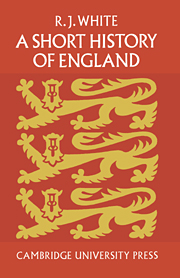Book contents
- Frontmatter
- Preface
- Contents
- Introduction: On the Character of English History
- 1 Roman Britain
- 2 Saxon England
- 3 The Anglo-Norman State
- 4 Common Law and Charter
- 5 The High Middle Ages
- 6 The Nation-State
- 7 The first Elizabethan Age
- 8 The Civil War
- 9 The Withdrawing Roar
- 10 The Century of Success
- 11 The first British Empire
- 12 The Age of Everything
- 13 War and Peace
- 14 Victorian Ages
- 15 Imperial and Edwardian
- Postscript
- Further Reading
- Index
15 - Imperial and Edwardian
Published online by Cambridge University Press: 14 November 2009
- Frontmatter
- Preface
- Contents
- Introduction: On the Character of English History
- 1 Roman Britain
- 2 Saxon England
- 3 The Anglo-Norman State
- 4 Common Law and Charter
- 5 The High Middle Ages
- 6 The Nation-State
- 7 The first Elizabethan Age
- 8 The Civil War
- 9 The Withdrawing Roar
- 10 The Century of Success
- 11 The first British Empire
- 12 The Age of Everything
- 13 War and Peace
- 14 Victorian Ages
- 15 Imperial and Edwardian
- Postscript
- Further Reading
- Index
Summary
The Crimean War was fought by Britain and France in alliance with the Turks to halt Russian advance towards Constantinople and the Straits. This was vital to Great Britain in order to safeguard the short route to India. The year after the Peace of Paris had registered the neutralizing of the Black Sea, the outbreak of the Indian Mutiny brought a complete reassessment of British policy in governing India. For nearly fifty years, British land policy in the subcontinent had been dominated by concern to protect the peasant and his traditional way of life at the expense of a native aristocracy and its servants. It was the annexation of Oudh in 1856, and the wholesale institution there of the village settlements and land tenures of the North-West Provinces, that sparked off the Mutiny. By the summer of 1859 not only Oudh but the whole of upper India, with the exception of the garrison at Lucknow, was aflame with rebellion. The peasant settlement of 1856 came to an end in a matter of weeks. ‘It might have been expected that … the village occupants who had been so highly favoured by the British Government … would have come forward in support of the Government’, wrote Lord Canning, the Governor-General. ‘Such however was not the case.’ Instead of arousing the gratitude and loyalty of the peasant by building up his proprietary rights it seemed that the policy had provoked him into hostility.
- Type
- Chapter
- Information
- A Short History of England , pp. 264 - 280Publisher: Cambridge University PressPrint publication year: 1967



